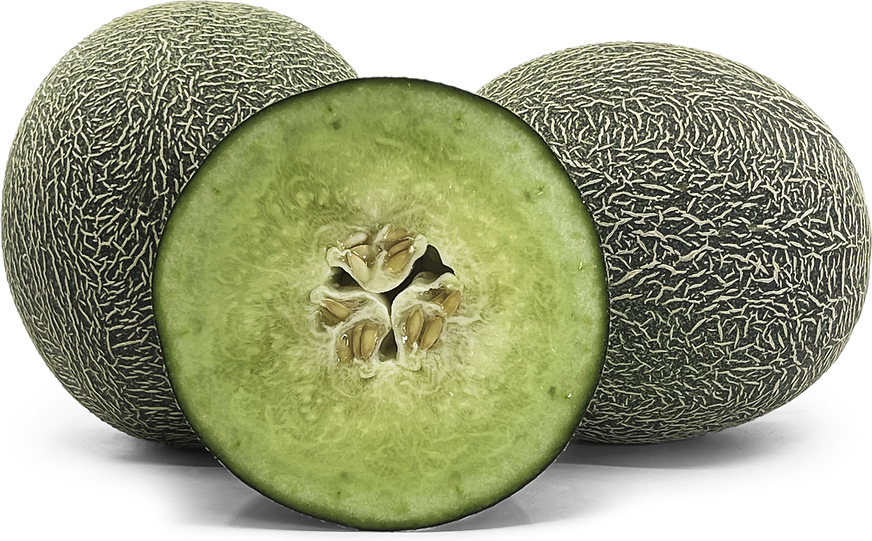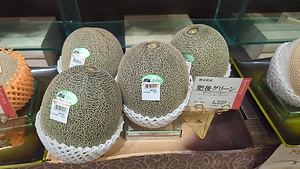


Higo Green Melons
Estimated Inventory, lb : 0
Description/Taste
Higo Green melons are a uniform varietal, averaging 3 to 3.5 kilograms in weight, and have a round, oval, to oblong appearance with blunt, curved ends. The melon’s rind has a dark green base, often described as jade or emerald in color, and is covered in a raised layer of brown netting. The rind is firm, taut, rough, and textured. The netting is typically comprised of thin, short lines. Underneath the rind, the pale green flesh is dense, aqueous, and firm, with a crisp but succulent consistency. The variety is known for its large amounts of flesh and encases a small central cavity filled with membranes and seeds. The tan to ivory seeds have a tear-drop shape and are coated in a slippery layer. Select Higo Green melons that feel heavy for their size and bear a fine netting. If the melons have stems still attached, look for melons with fresh, non-shriveled stems. Higo Green melons have a high sugar content, between 14 to 16 degrees Brix, and emit a sweet, refreshing, and slightly floral taste. Despite their sugar content, the flesh is not overwhelmingly sugary but has a mild, clean flavor.
Seasons/Availability
Higo Green melons are available from May through August.
Current Facts
Higo Green melons, botanically classified as Cucumis melo, are a Japanese variety belonging to the Cucurbitaceae family. The netted, green-fleshed melons are favored for their refreshingly sweet taste and firm nature and are a specialty variety grown in limited quantities in Japan. Higo Green melons are harvested later than other commercial melons, approximately 65 days after flowering, and the rind develops its signature appearance from the fruit’s rapid growth. The exterior of the melon cannot keep up with the overall expansion of the fruit, causing the skin to crack and heal. This occurs several times throughout cultivation, developing the raised pattern on the melon’s surface. Higo Green melons are also notably grown using the ichiki ichika method, meaning one fruit is allowed to grow on each vine. This permits the plant to focus on developing one melon, contributing to an improved flavor. The melons are monitored by their sugar levels, and once the fruits are determined ideal for picking, they are hand-harvested to protect their overall appearance and attached stem. Higo Green melons are considered a luxury variety in Japan. The fruits are primarily grown in the Kumamoto Prefecture and have often been nicknamed the Kumamoto Melon for their ties to the region. Higo Green melons are seasonal fruits eaten fresh and are incorporated into a wide array of sweet or savory preparations.
Nutritional Value
Higo Green melons are a source of vitamin C to strengthen the immune system, fiber to regulate the digestive tract, and potassium to balance fluid levels within the body. Melons also provide magnesium to control nerve functioning, iron to develop the protein hemoglobin for oxygen transport through the bloodstream, antioxidants to protect the cells against damage caused by free radicals, and other nutrients, including vitamin K, folate, and vitamin B6. Melons are also viewed as a source of hydration due to their high water content. The flesh is savored as a refreshing reprieve on hot summer days throughout Japan.
Applications
Higo Green melons have a mild, sweet taste suited for fresh and cooked preparations. The variety is traditionally consumed out of hand and is savored for its firm but juicy flesh. Higo Green melons must be washed before opening to remove bacteria and dirt from the netted surface. Once cleaned, chilling the flesh for 1 to 2 hours before serving is recommended to enhance the overall eating experience. Higo Green melons can be sliced into wedges and eaten as a refreshing snack, or the flesh can be tossed into salads. The flesh also complements parfaits and can be skewered with other fruits as a bite-sized appetizer. The sweetest portion of the flesh will be around the seed cavity. Higo Green melons can also be wrapped in prosciutto as a savory dish or served with fresh whipped cream as a light dessert. In addition to slightly chilled preparations, Higo Green melons can be blended and frozen into popsicles, shaved ice, sorbet, and ice cream. They can also be blended into smoothies, shakes, juices, and cocktails. In Japan, Higo Green melons can be used in any recipe calling for melon. The variety can be included as part of the filling in melon bread or added to jellies, custards, and puddings. They can also be sliced fresh over cakes and tarts. Higo Green melons pair well with grapes, blueberries, strawberries, and citrus, herbs including mint, basil, and lemongrass, honey, maple syrup, and fresh cheeses. Whole, unopened Higo Green melons should be ripened at room temperature. Once mature and ready to eat, the melons can be stored in the refrigerator. Sliced melons should be wrapped in plastic and placed in the fridge.
Ethnic/Cultural Info
Higo Green melons are named after their green coloring and the prefecture they are mainly grown in. Higo is an old name for Kumamoto, and the variety is famous for its cultivation in the prefecture. Kumamoto is said to have a warm climate that is ideal for melon cultivation. The region has ample water sources, and most melon fields are at sea level. This low-lying characteristic allows salt and minerals from seawater to seep into the soil, mixing with groundwater to create a distinct growing environment. Melon plants absorb these nutrients, and it is said the salt-filled soil contributes a richer flavor to the fruits. Outside of Kumamoto, Higo Green melons are grown under the name Perle melons. One of the most memorable sites for melons is the Melon Dome Roadside Station in Shichijo-cho in Kikuchi City within the Kumamoto Prefecture. The station is situated alongside National Route 325 and features three large domed roofs, said to look like halves of melons. The Melon Dome Roadside Station sells locally grown melon varieties, including Higo Green and melon-centric treats. Since its creation, the station has become a popular tourist attraction, and melon enthusiasts seek out seasonal items such as melon bread, ice cream, jellies, and fresh juices.
Geography/History
Higo Green melons are native to Japan and were developed by Matsui Seed Co. in the Nara Prefecture. Much of the variety’s history is unknown, but it was thought to have been created sometime around 1989. During this time, red-fleshed melon varieties were the most prized melons, but over time, preferences throughout Japan shifted to include green-fleshed melons. Higo Green melons were eventually planted in the Kumamoto Prefecture and were named in honor of this growing region. They are especially grown in Yatsushiro City within the Kumamoto Prefecture. In 2023, Higo Green melons were introduced to the United States and were planted in the experimental fields of the Mount Vernon Northwestern Research & Extension Center. The variety was chosen for evaluation in the American market as Matsui Seed Co.’s president, Kunihiko Matsui, attended a program at Washington State University. Matsui partnered with the university in 2023 and planted multiple Higo Green melon crops for possible introduction as a commercial cultivar. Today, Higo Green melons are still primarily grown in Japan. The melons are sold domestically in Japan and exported to other Asian countries, including Malaysia.








